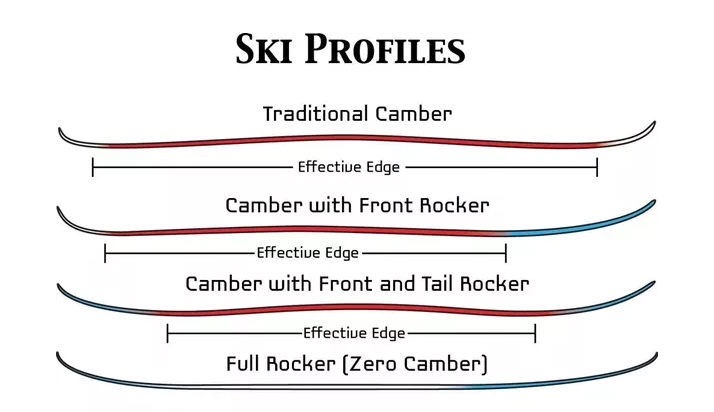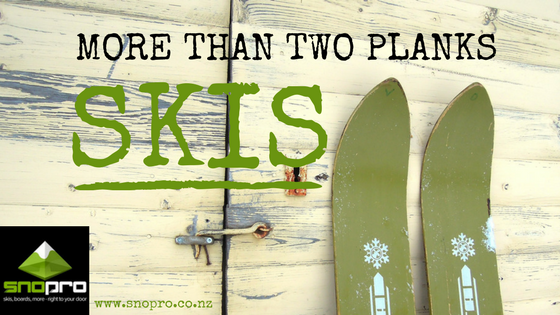Snopro is no ordinary ski hire shop.
The unique ski rental delivery service is more akin to online shopping.
No long queues.
No sharp elbows
No disgruntled staff members.
Sit back and relax knowing your own personal ski technician is on route.
'Skis? Oh, I've got a guy for that'.

Whilst our virtual booking assistant does most of the work helping you select skis, you might want to find out a little more about what equipment to expect. Explore Snopro ski hire's equipment, from the budget Progression package to the ductile Premier series.
Progression Ski Hire
The Progression range generally consists of a basic ski that is soft and easy to use for a beginner.
They are piste skis that combine decent sidecut and camber, suited to gentle piste cruising.
A good ski to learn on but its soft flex means intermediate and advanced skiers should not use this ski.
For better skiers, it will become unstable at high speeds or when carving. It will be good for the first few days of learning to ski.
Performer Ski Hire
The Performer series consists of good level piste skis that beginners up to strong level intermediates will enjoy.
It's soft to mid-level flex means it will work as an easy piste cruiser that gives beginners the ability to progress whilst also being able to handle some aggressive carving.
Tip and tail rocker allows easy manoeuvrability when on a flat base but then allows the full length of the ski to engage the snow when put on edge.
Even an advanced skier on a budget can take the ski out without feeling unstable.
A ski that caters to all abilities.
Premier Ski Hire
The Premier package gives you a greater range of skis to suit their style.
Many of these skis are all-mountain piste skis that have a good camber, sidecut and tip and tail rocker.
Combined with some width underfoot it allows the ski to ride variable snow and off-piste without sacrificing on-piste performance.
Other skis include stiff piste skis, also known as 'front side' ski.
These are designed for aggressive piste riding.
Freeride skis are available with a lot more width throughout the ski, a large tip rocker and lightweight give great off-piste ability, great for heliskiing.
Except for the top sheet design, female-specific skis have a few technical differences.
Bindings will be set slightly more centrally located with a raised heel piece.
This is to account for the different angle of a woman’s pelvis and makes the ski easier for females to use.
The bases are sometimes thinner and lightweight materials are used to make the ski.
What Does It All Mean? Ski Terminology Explained
To help understand the terminology used in the ski industry here are some of the terms used;
Rocker and Camber
The vast majority of skis are now being built with tip and tail rocker.
The 'tip' and the 'tail' of skis curve up into the air whilst the middle is in contact with the ground. This is rocker. It means you have less of the ski base touching the ground, making the ski shorter and easier to control.
Having this effect will also allow you to move the ski onto its edge meaning it is easier for you to initiate a turn. As the ski gets on to the edge the full length will take hold allowing you to carve with the full edge of the ski.
Off-piste skis will have a very obvious amount of rocker to allow the ski to float in deep snow by keeping the tips on the surface.
Rather than having a full banana shaped ski, many manufacturers put the rocker in the tip and tail of the ski to enable changes in the shape of the ski as you move between the flat base and your edges.

In between the rocker of tip and tail is the 'camber'. This is when the waist of the ski is raised off the ground when no weight is placed on the ski. Camber is essential to any piste skiing. It works in a similar fashion to a spring helping to pop and drive through the exit of a turn.
Sidecut
The sidecut of a ski is the edge shape of the ski. Tip and tail will be wider than the middle/underfoot of the ski. The larger the side cut often means a tighter turning/more aggressive on the piste.
Ski Radius
The radius of a ski is the turning circle. A short piste ski will have a dramatically smaller radius compared to a long freeride ski. Piste skis may have a radius of 12 to 16 metres and a freeride ski will have a radius of 18 metres plus. The bigger the sidecut, the smaller the radius.
Ski Flex
A ski’s ‘flex’ refers to the stiffness. Flexible 'soft' skis usually offer more suitability to a beginner as they are forgiving and easy to use. Freestyle skis and Freeride skis can also be soft but this is not a problem as they are not used for high speed or aggressive carving.
Stiffer skis suit stronger skiers with better technique, downhill race skis are the stiffest of all. They can cope with high levels of pressure in the ski whilst remaining stable. A skier’s weight is also considered when looking at using the correct flex, a heavier skier may need a ski that is a little bit stiffer.
Twin-tips
The ski tail curves like the tip of the ski to enable skiing backwards, usually for freestyle skis. True park and pipe freestyle skis are often symmetrically shaped with bindings mounted centrally on the ski. This enables an even riding performance both forwards and backwards. Take a look at our tweener series for a wide selection of twin-tip skis.
Underfoot
The underfoot measurement is the width of the ski at the middle or under the ski boot.
Piste skis will have an underfoot measurement of around 60 to 76 mm.
All-mountain will have an underfoot measurement of around 76 to 95 mm.
Off-Piste skis are much wider underfoot and can be 95 mm up to around 130 mm. Generally, wider skis offer less piste performance and more off-piste performance.
Looking to learn even more about skis then head over to our 'More Than Two Planks' feature. Read more>>
